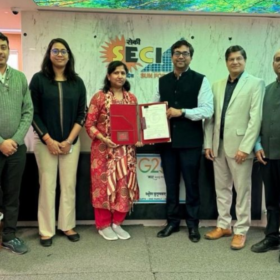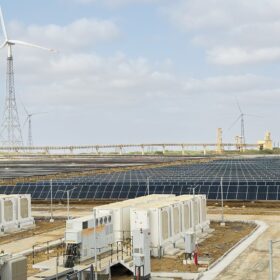Global energy systems are experiencing a massive shift. From the urgency to address climate change to ensuring energy access, a transformation is underway. According to existing global energy forecasts, fossil fuels, which have long dominated the energy mix, are predicted to fall from their historic average of 80 per cent to 73 per cent by 2030. For the first time, demand for coal, oil, and natural gas is expected to peak this decade. This turning point marks a clear signal: the future belongs to renewable energy.
India, a major developing country, stands on the verge of this transition. With one of the world’s most ambitious clean energy targets (500 GW of non-fossil fuel capacity by 2030), the nation is swiftly laying the foundation for a sustainable energy economy. However, there exist certain challenges as we progress from potential to performance. Projects that should take 12-18 months to complete often take twice that. More often than not, land acquisition challenges, regulatory overreach and delayed transmission planning are the reasons behind this.
This lag underscores a larger truth: engineering excellence alone cannot drive the energy transition. Speed in execution and policy synergy are no longer optional. In order to bridge this gap between ideation and execution, central and state governments are required to streamline approval processes. Moreover, the alignment of incentives and coordinated planning is also necessary. Consequently, renewable energy can become both an environmental safeguard and an economic catalyst.
Speed: The missing element
Time is an important consideration in renewable energy projects, yet delays remain a key obstacle. Usually, land acquisition, forest clearing and transmission planning are delayed. As a result, significant delays are caused in executing renewable projects. Even when projects get completed, transmission infrastructure may not be ready thereby impeding ability to transmit the electricity produced. Furthermore, India’s capacity to meet sustainable energy ambitions suffers a setback. What should be a swift transition from land to light often becomes a prolonged bureaucratic process, preventing India from fully capitalising on its renewable energy potential.
The need for government policies
While execution speed is important, it must be supported by a coordinated policy framework. Without collaboration of governments and regulatory authorities, the renewable energy ecosystem risks working in silos, limiting growth and compromising results.
In order to create a supportive environment for renewable projects across industries, five areas of policy synergy demand immediate attention:
- Integrated Single-Window Clearance: Fragmented approvals (land use, forest clearance, transmission access)—must converge into a unified, digital platform. This will drastically reduce delays and improve transparency for developers.
- Decentralised Grid Planning: States must align transmission and distribution infrastructure development with identified renewable energy zones. This becomes even more critical as hybrid and round-the-clock (RTC) projects proliferate, demanding flexible and robust grid support.
- Faster Dispute Resolution and Payment Security: Investor confidence hinges on predictable enforcement of contracts and timely payments. These include cross-border or multi-stakeholder projects. Mechanisms for quick dispute resolution must be institutionalised.
- Support for Domestic Manufacturing: With the Production Linked Incentive (PLI) Scheme, India is making strides in building solar PV manufacturing capacity. Tranche II of the scheme, covering over 39,900 MW, is projected to create over 100,000 jobs and attract more than USD 11 billion in investment. This is further contributing to energy independence and industrial resilience.
- Stable, Long-Term Policy Outlook: Regulatory consistency is important. Frequent shifts in tariffs, compliance norms, or approval procedures can erode trust. A predictable policy environment attracts long-term capital and accelerates project pipelines.
Engineering innovation: Meeting energy transition
Another factor pushing renewable energy uptake is technological innovation. In recent times, solar, wind and bioenergy systems have evolved. Their evolution is largely reliant on technical advancements, boosting efficiency and reducing prices. In addition, high-efficiency solar cells, bifacial modules, offshore wind turbines, and the latest monitoring systems have transformed renewable energy deployment.
For industrial sectors—among the largest energy consumers—integrating renewable energy has become more vital than ever. This is because the integration of renewable energy improves operating efficiency and reduces emissions. Also, it boosts long-term resilience. The modern-age industrial engineers are reshaping systems by using data analytics and automation – optimising energy usage.
This synergy of innovation and sustainability has implications beyond energy. It is changing the way industries design, produce, and deliver. In other words, renewable energy is not just powering production; it is redefining it.
The views and opinions expressed in this article are the author’s own, and do not necessarily reflect those held by pv magazine.
This content is protected by copyright and may not be reused. If you want to cooperate with us and would like to reuse some of our content, please contact: editors@pv-magazine.com.








By submitting this form you agree to pv magazine using your data for the purposes of publishing your comment.
Your personal data will only be disclosed or otherwise transmitted to third parties for the purposes of spam filtering or if this is necessary for technical maintenance of the website. Any other transfer to third parties will not take place unless this is justified on the basis of applicable data protection regulations or if pv magazine is legally obliged to do so.
You may revoke this consent at any time with effect for the future, in which case your personal data will be deleted immediately. Otherwise, your data will be deleted if pv magazine has processed your request or the purpose of data storage is fulfilled.
Further information on data privacy can be found in our Data Protection Policy.